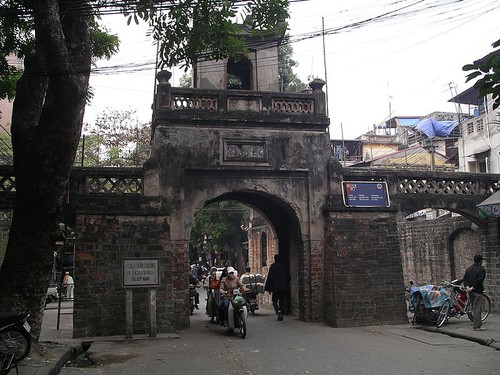(VOVworld) – Hanoi once had five gates which strongly embodied its historical developments. The beauty of these gates features in several songs about Hanoi.
 |
According to historical records, there was a wall with gates surrounding the Thang Long citadel. The gates were square and were under strict surveillance. They were open during the day and closed at night. In King Le Hien Tong’s reign in the 18th century, there were 16 square gates, but by the early 20th century, there were only 5 gates: Cau Giay, Cau Den, Cho Dua, Dong Mac and Quan Chuong. Some gates were pulled down because of war damage, but their names lived on as the names of districts or streets: Cau Giay district, O Dong Mac ward, O Cau Den ward and O Cho Dua ward. Today, only the Quan Chuong gate survives as a proper "square gate”. Quan Chuong gate on Hang Chieu street, Hoan Kiem district, was part of the wall east of the ancient Thang Long citadel. Covered with moss, the gate and part of the wall have survived the ravages of time. On the gate there is a sign that says " Dong Ha gate” but local people prefer to call it "Quan Chuong Gate." Historian Duong Trung Quoc told VOV: "Quan Chuong is the only entrance to the city that retains its original architecture. There is a stele dating back to the Nguyen Dynasty in 19th century, which states that surveillance should be strict without disturbing the life of the people. Why was the gate named Quan Chuong? It might be the name of a chief guard, who was so loved by the locals that they gave histitle to the entrance gate he guarded”.
Other historical sources say people called the gate Quan Chuong which means chief guard, to honor the Chief guard who led a hundred soldiers in a brave fight against the French in 1873, when they attacked Hanoi for the first time through this gate.
Quan Chuong gate exhibits a typical architecture of the Nguyen Dynasty. It consists of two levels, the lower level has three arched doorways and the upper level is covered by 4 roofs decorated with a motif of hexagonal or quadrilateral asterisks. The guards were stationed on the upper level. Today, Quan Chuong gate exists as a page of history at the heart of Hanoi. Truong Van Khanh lives near Quan Chuong gate: "We are proud to live in the neighborhood of Quan Chuong gate which has existed for centuries. We hope it will be restored and preserved. It is a witness of Vietnamese culture and tradition of struggle”.
Quan Chuong gate was restored in 1804 and again in 1817, during the reign of King Gia Long. In 1994, it was officially recognized as a historic relic site. In 2010, it was restored once again. For Hanoians, Quan Chuong gate is not just a relic of the ancient Thang Long capital but a proud symbol of the modern capital city.